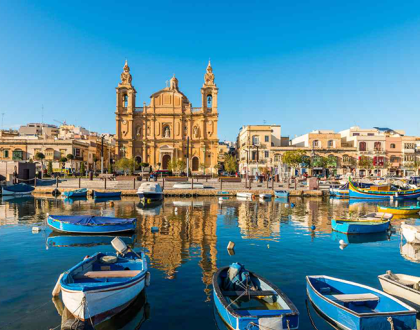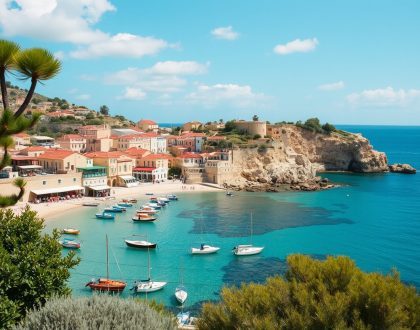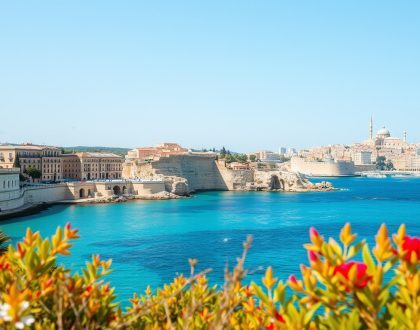History and Vibrant Culture of Malta

Before delving into the rich #history and vibrant #culture of #Malta, it is crucial to understand the #geographical tapestry that sets the backdrop for this fascinating archipelago in the #Mediterranean Sea. The Maltese Islands, located south of Sicily, consist of three main islands: Malta, Gozo, and Comino. These islands are renowned for their limestone cliffs, hidden coves, and crystal-clear waters that attract visitors from all over the world.
The Maltese Archipelago: An Overview
One of the standout features of the Maltese archipelago is its strategic location at the crossroads of Europe, Africa, and the Middle East. This favorable position has made Malta a melting pot of diverse cultures and influences throughout history. The islands boast a rich maritime history, with evidence of ancient seafaring civilizations dating back to Neolithic times, making it a treasure trove for archaeologists and history enthusiasts.
Malta's Climate and Environment
Overview: Malta enjoys a Mediterranean climate characterized by hot, dry summers and mild, wet winters. The islands are known for their abundant sunshine, with over 300 days of sunshine per year. This pleasant climate, combined with the stunning natural landscapes of cliffs, valleys, and beaches, makes Malta a popular destination for tourists seeking both relaxation and adventure. This breathtaking archipelago is not only a haven for sun-seekers but also a paradise for nature lovers and outdoor enthusiasts. The rugged terrain of Malta offers opportunities for hiking, rock climbing, and water sports, attracting thrill-seekers from around the globe. With its unique blend of history, culture, and natural beauty, Malta offers a truly unforgettable experience for visitors of all interests.
Key Cities and Their Historical Significance
An exploration of Malta would not be complete without a visit to its key cities, each with its own historical significance. Valletta, the capital city, is a UNESCO World Heritage Site known for its well-preserved Baroque architecture and rich history dating back to the era of the Knights of St. John. Mdina, the ancient capital, is a charming fortified city that transports visitors back in time with its winding streets and historic buildings.
Climate: The Mediterranean climate of Malta provides the perfect backdrop for exploring its key cities, with mild winters and warm summers creating an inviting atmosphere for sightseeing and outdoor activities. The coastal cities of Sliema and St. Julian's offer vibrant nightlife and waterfront promenades, while the fishing village of Marsaxlokk provides a glimpse into traditional Maltese life. Whether you're immersing yourself in history or soaking up the sun on a sandy beach, Malta's key cities offer a diverse range of experiences for every traveler.
Prehistoric Foundations
Even before recorded history began, the Maltese archipelago was already a hub of human activity. The prehistoric period in Malta is well-known for its megalithic temples, which are some of the oldest free-standing structures in the world. These temples are believed to have been constructed between 3600 BC and 700 BC, making them older than Stonehenge and the Great Pyramids of Giza.
The Megalithic Temples
Any visitor to Malta cannot miss the awe-inspiring megalithic temples that dot the islands. These temples bear witness to the advanced architectural skills of the ancient Maltese people, who were able to move massive stone blocks weighing several tonnes to create these monumental structures. The temples served as places of worship and rituals, with intricate carvings and decorations adorning their interiors.
These temples, such as Ġgantija and Ħaġar Qim, have stood the test of time and provide a fascinating glimpse into Malta's prehistoric past. They are designated as UNESCO World Heritage Sites and continue to attract researchers and history enthusiasts from around the globe.
The mysteries surrounding the construction and purpose of these temples only add to their allure, making them a must-see for anyone interested in Malta's rich history.
Underground Marvels: The Hypogeum
Foundations deep beneath the surface of Malta lie a unique underground structure known as the Hypogeum. This underground complex, believed to date back to around 4000 BC, is one of the only prehistoric underground temples in the world. Carved out of solid rock, the Hypogeum is a testament to the ingenuity and craftsmanship of ancient Maltese society.
This subterranean marvel comprises intricate chambers, passageways, and halls, creating an otherworldly experience for visitors. The Hypogeum is a significant archaeological site, offering valuable insights into the spiritual and cultural practices of Malta’s early inhabitants.
Artifacts and Fossil Records
This subheading will explore the various artifacts and fossil records that have been unearthed in Malta, shedding light on the daily lives and activities of its prehistoric residents. From pottery and tools to human remains and animal fossils, these discoveries provide a glimpse into the customs, rituals, and environment of ancient Malta.
An in-depth examination of these artifacts and fossil records can help piece together the puzzle of Malta’s prehistoric past, offering clues to how its early inhabitants lived, interacted, and thrived on the islands.
It is crucial to preserve and study these valuable artifacts and fossils to deepen our understanding of Malta's rich prehistory and ensure that this fascinating heritage is passed down to future generations.
The Influence of Strategic Location
Malta at the Crossroads of Civilizations
To understand the rich tapestry of Maltese culture, one must first appreciate its strategic location in the heart of the Mediterranean. Malta's position at the crossroads of Europe, Africa, and the Middle East has made it a coveted prize for various empires throughout history. This strategic location has not only shaped the island's history but has also left a lasting impact on its culture.
The Phoenicians, Romans, Moors, Normans, Knights of St. John, and the British are just a few of the civilizations that have controlled Malta at different points in time. Each of these conquerors brought their own customs, traditions, languages, and religions, contributing to the diverse cultural melting pot that is present in modern-day Malta. This fusion of influences has created a unique identity that sets Malta apart from its neighbors.
Despite its small size, Malta's strategic location has made it a melting pot of cultures, with each conqueror leaving its mark on the island. From language to architecture, Malta bears the influence of its diverse history. The blending of these cultures has resulted in a rich and vibrant society that continues to thrive today, attracting visitors from around the world who come to experience the unique blend of traditions that make up Maltese culture.
The Impact of Various Conquerors on Maltese Culture
The influence of various conquerors on Maltese culture is profound and can be seen in every aspect of daily life. The Arabs, for example, introduced intricate tile work and ornate patterns that are still prevalent in Maltese architecture. The Normans, on the other hand, left behind a legacy of feudalism and a system of governance that can still be observed in Malta's institutions.
One of the most significant impacts on Maltese culture came from the Knights of St. John, who transformed the island into a formidable fortress and built many of the iconic buildings that still stand today. The British period also left its mark, with English becoming one of the official languages of Malta and the introduction of a parliamentary system of government that remains in place.
Despite the challenges of being constantly at the mercy of changing empires, the Maltese people have managed to preserve their unique identity and culture. This resilience is a testament to the strength of the Maltese spirit and their ability to adapt and thrive in the face of adversity.
Malta under the Knights of St. John
The Order of St. John: Guardians of Malta
Unlike its turbulent past under various ruling powers, Malta found stability and protection under the Knights of St. John, also known as the Knights Hospitaller. The order, originally established in Jerusalem during the Crusades, played a pivotal role in safeguarding the island from Ottoman invasions in the 16th century.
On Malta, the Knights built a formidable defense system, with the capital city of Valletta as its primary fortress. Their naval prowess and military acumen made them a formidable force in the Mediterranean, and their dedication to the protection of Malta was unwavering.
The Knights of St. John left an indelible mark on Malta, shaping its culture and architecture in significant ways. Their legacy can still be seen today in the numerous fortifications and landmarks that dot the Maltese landscape, serving as a reminder of their role as protectors of the island.
Chivalry and Fortifications
Guardians of the island, the Knights of St. John were not only skilled warriors but also epitomes of chivalry. Their commitment to protecting the weak and upholding the values of honor and bravery defined their ethos.
The fortifications they constructed, including the iconic St. John's Co-Cathedral and the imposing Fort St. Angelo, stand as testaments to their military prowess and architectural ingenuity. These structures not only served as defensive bastions but also as symbols of the order's dedication to Malta.
The intricate network of defenses and watchtowers built by the Knights of St. John transformed Malta into a formidable fortress, earning it the moniker “The Most Fortified City in the World.” Their strategic positioning and innovative design made them a formidable adversary for any would-be invaders.
Baroque Splendor and Legacy
Chivalry and grandeur defined the era of the Knights of St. John in Malta, as evidenced by the architectural wonders they left behind. The Baroque style, characterized by ornate embellishments and lavish decorations, flourished under their patronage.
The impact of the Knights' Baroque legacy can be seen in the opulent palaces, churches, and gardens they commissioned, such as the Grand Master's Palace and the Upper Barrakka Gardens. These architectural marvels continue to attract visitors from around the world, showcasing the Knights' enduring influence on Malta's aesthetic identity.
The legacy of the Knights of St. John in Malta is one of valor, culture, and resilience. Their dedicated stewardship of the island during a pivotal period in its history has left an indelible mark that continues to shape Malta's identity to this day.
The British Era and the Road to Independence
British Rule in Malta: Military and Strategic Importance
Keep in mind that Malta's strategic position in the Mediterranean made it a coveted prize for various powers throughout history. The British recognized the island's importance and took control of Malta in the early 19th century, during the Napoleonic Wars. The Maltese islands served as a crucial naval base for the British Empire, allowing them to control the Mediterranean and safeguard their trade routes to the East.
Under British rule, Malta became an important military outpost and played a significant role in various conflicts, including both World Wars. The island was heavily fortified, particularly during World War II, when Malta withstood intense bombing campaigns by the Axis powers. The resilience and bravery of the Maltese people during this challenging period earned them the George Cross, a testament to their courage and perseverance.
The British military presence shaped Malta's identity and left a lasting impact on its culture and heritage. Today, remnants of this era can still be seen in the many forts, barracks, and military installations scattered across the islands, serving as a reminder of Malta's strategic significance in the past.
Economic and Social Development under the British
On the economic and social front, British rule brought significant changes to Malta. Infrastructure development, such as the establishment of a modern port and the construction of new roads and buildings, transformed the face of the islands. The British also introduced new legal and administrative systems, laying the groundwork for a more organized and efficient society.
Furthermore, the British influence extended to education and healthcare, with the establishment of schools, hospitals, and other public services. This period saw the gradual modernization of Malta's economy, as traditional industries like agriculture gave way to new sectors such as tourism and manufacturing. The influx of British investment and expertise helped spur economic growth and create new opportunities for the Maltese population.
Independence brought about a new chapter in Malta's history, as the island transitioned from being a British colony to a sovereign nation. The road to independence was marked by political activism and a growing desire for self-determination among the Maltese people. In 1964, Malta achieved independence from Britain, becoming a constitutional monarchy with Queen Elizabeth II as its head of state.
The Path to Independence
An important milestone in Malta's journey to independence was the drafting of a new constitution in 1961, which granted the island greater self-government and paved the way for full independence. The Maltese people gained more control over their internal affairs, marking a significant step towards sovereignty. Finally, in 1974, Malta became a republic, severing its ties with the British monarchy and establishing itself as a fully independent state.
As an independent nation, Malta was able to shape its own destiny and forge its unique identity on the world stage. The newfound independence opened up opportunities for economic growth and international partnerships, allowing Malta to become a respected member of the global community. Today, Malta continues to thrive as a sovereign nation, building on its rich history and embracing a bright future ahead.
Culture and Identity
Language: A Melting Pot of Influences
After centuries of being at the crossroads of different civilizations, Malta's language reflects its diverse history. Maltese, the only Semitic language written in Latin script, is the national language, with English also having official status. This linguistic duality is a testament to the various influences that have shaped the Maltese culture over the years, including Arabic, Italian, and French elements.
Religion in Maltese Life
Any discussion of Maltese culture would be incomplete without mentioning the significant role that religion plays in the daily lives of the Maltese people. Over 90% of the population are Roman Catholic, making Catholicism a central pillar of Maltese identity. Churches and religious festivals are integral to the social fabric of Malta, with Good Friday and Easter Sunday being particularly important occasions.
Maltese society respects and upholds religious traditions, with many families attending church services regularly and actively participating in religious events. The influence of Catholicism can be seen in various aspects of Maltese life, including the strong emphasis on family values, community solidarity, and compassion towards others.
Festas and Traditions: Celebrating Saint's Days
Identity, community, and tradition converge during the colorful and lively festas that take place throughout Malta and Gozo. These religious celebrations, dedicated to the patron saints of each town or village, involve elaborate processions, fireworks, band marches, and feasting.
Life comes to a standstill during these festas, as residents come together to honor their saints, reaffirm their cultural heritage, and strengthen community bonds. Each festa is a unique reflection of local identity, with traditions passed down through generations, showcasing the rich tapestry of Maltese customs and beliefs.
Music, Dance, and Theatrical Expression
Days of celebration in Malta are often accompanied by vibrant musical performances, traditional dances, and theatrical expressions that capture the spirit and energy of the Maltese people. Folk music with its distinctive rhythms and instruments, such as the Maltese mandolin, adds a lively soundtrack to cultural events and festivities across the islands.
Traditional dances like the Għana and Freedance showcase the unique movements and storytelling elements that are deeply entrenched in Maltese heritage. Theatrical performances, from ancient Mumming plays to contemporary productions, offer a glimpse into the creative expression and artistic innovation that characterize Malta's cultural scene.
Maltese Cuisine: A Culinary Journey
Many travelers to Malta are captivated by the country's unique and delicious cuisine, which reflects a rich tapestry of influences from its storied past.
The Influence of History on Maltese Gastronomy
One cannot discuss Maltese gastronomy without acknowledging the profound impact of the country's history on its culinary traditions. Over the centuries, Malta has been ruled by various civilizations including the Phoenicians, Romans, Moors, Knights of St. John, and British, each leaving their mark on the island's cuisine. This diverse history has resulted in a fascinating fusion of flavors and techniques that define Maltese food today.
Classic Maltese Dishes and Ingredients
Gastronomy in Malta is characterized by a range of classic dishes and ingredients that showcase the island's culinary heritage. Traditional Maltese fare often includes ingredients such as olives, capers, tomatoes, and locally sourced seafood like swordfish and octopus. Popular dishes like rabbit stew (Fenek) and pastizzi (flaky pastries filled with ricotta cheese or mushy peas) are beloved by locals and visitors alike.
For instance, the national dish of Malta, ‘Fenkata', is a hearty rabbit stew slow-cooked with red wine and aromatic herbs, reflecting the island's agricultural traditions and love for robust flavors. Another iconic dish, ‘Stuffat tal-Qarnit', features tender octopus simmered in a savory tomato sauce with capers and olives, a testament to Malta's maritime history and culinary ingenuity.
The Evolution of Maltese Wine and Brewing
Maltese wine and brewing have also played a significant role in shaping the country's culinary landscape. Malta boasts a long history of winemaking dating back to Phoenician times, with indigenous grape varieties like Girgentina and Gellewza producing unique wines with complex flavors. In recent years, a resurgence of craft breweries has added a modern twist to Malta's brewing scene, offering a variety of artisanal beers that complement the island's cuisine.
Maltese winemakers are known for their innovative techniques and dedication to quality, resulting in a burgeoning wine industry that has gained international recognition. From rich red wines to crisp whites and refreshing rosés, Malta's winemaking tradition continues to evolve, delighting wine enthusiasts and food lovers alike.
Another notable development in Malta's brewing scene is the rise of microbreweries producing small-batch beers with bold flavors and creative ingredients. These craft brewers are exploring new flavor profiles and pushing the boundaries of traditional brewing methods, contributing to a dynamic and exciting beer culture on the island. With a growing interest in locally sourced and artisanal products, Malta's wine and brewing industries are poised to continue thriving, offering visitors a taste of the island's unique terroir and vibrant culinary scene.
Contemporary Malta
Modern Governance and the Economy
One of the most notable aspects of modern Malta is its governance structure and economic development. The country operates as a parliamentary republic, with a President serving as the head of state and a Prime Minister as the head of government. The Maltese economy has experienced significant growth in recent years, with sectors such as tourism, financial services, and manufacturing playing a crucial role in driving economic prosperity.
Furthermore, Malta has implemented various policies to attract foreign investment and promote business growth. The country's strategic location in the Mediterranean has made it a hub for international trade and commerce. Additionally, Malta's membership in the European Union has provided access to a wider market and opportunities for economic advancement.
The government of Malta continues to prioritize sustainable development and innovation to ensure long-term economic stability. With a focus on enhancing infrastructure, promoting entrepreneurship, and investing in education and technology, Malta remains committed to fostering a vibrant and resilient economy that benefits its citizens and businesses alike.
Malta in the European Union
Contemporary Malta's integration into the European Union has brought about numerous benefits and opportunities for the country. As a member state since 2004, Malta has access to the single market, allowing for the free movement of goods, services, capital, and people within the EU. This integration has facilitated trade, investment, and collaboration with other European countries, contributing to Malta's economic development.
In addition to economic advantages, Malta's EU membership has strengthened its political ties with other member states, enabling participation in decision-making processes that shape European policies and regulations. The country actively engages in various EU initiatives and programs, leveraging its position to advocate for its interests and contribute to the overall development of the European Union.
Furthermore, Malta's membership in the EU provides opportunities for cultural exchange, educational cooperation, and social integration. The country actively participates in European initiatives that promote diversity, unity, and collaboration among member states, reinforcing its commitment to European values and principles.
Social Issues and Current Affairs
With an emphasis on promoting social welfare and addressing contemporary challenges, Malta remains dedicated to tackling issues such as healthcare, education, housing, and social inequality. The government has implemented policies to enhance access to quality healthcare services, improve educational standards, and provide affordable housing options for its citizens.
Additionally, Malta continues to address social issues related to migration, gender equality, and LGBTQ rights, demonstrating a commitment to fostering inclusivity and diversity within its society. The country strives to create a welcoming and supportive environment for all individuals, regardless of background or orientation, promoting unity and social cohesion.
Moreover, Malta remains vigilant in monitoring current affairs and responding to emerging challenges, such as cybersecurity threats, climate change, and global pandemics. The government collaborates with international organizations and partners to address these issues, working towards sustainable solutions that protect the well-being of its citizens and the environment.
Environmental Challenges and Sustainable Initiatives
Modern Malta faces environmental challenges such as climate change, pollution, and sustainability concerns. The country has taken significant steps to address these issues by implementing sustainable initiatives and promoting environmental conservation efforts. One of the key priorities for Malta is reducing greenhouse gas emissions and transitioning towards renewable energy sources to mitigate the impacts of climate change.
Furthermore, Malta actively participates in international agreements and initiatives aimed at protecting the environment and preserving natural resources. The country has implemented policies to promote waste reduction, recycling, and sustainable practices in various sectors, including tourism, construction, and transportation. Plus, Malta is committed to preserving its unique biodiversity and natural landscapes through conservation projects and habitat restoration efforts.
By prioritizing environmental sustainability and green practices, Malta is working towards a more resilient and eco-friendly future. The country's efforts to balance economic development with environmental conservation demonstrate a commitment to protecting the planet and ensuring a sustainable future for generations to come.
The Maltese Diaspora
Emigration: Causes and Effects
For centuries, Maltese emigration has been driven by various factors such as economic opportunities, political instability, and seeking a better quality of life. The earliest waves of emigration from Malta took place in the 19th century, primarily to North Africa and the United States. The trend continued throughout the 20th century, with significant numbers of Maltese migrating to Australia, Canada, and the United Kingdom.
Emigration has had lasting effects on Maltese society, culture, and economy. The departure of skilled workers and young professionals has led to a brain drain, impacting the country's labor market and development. On the other hand, remittances sent back by emigrants have provided financial support to families in Malta and contributed to the local economy.
The Maltese diaspora has also played a role in shaping the global Maltese community and preserving Maltese identity abroad. Despite being scattered around the world, Maltese expatriates have maintained strong ties to their homeland through cultural events, associations, and maintaining the Maltese language within their families.
Contributions of the Maltese Diaspora
For generations, the Maltese diaspora has made significant contributions to their host countries in various fields such as healthcare, education, politics, and the arts. Maltese immigrants have excelled in professions ranging from medicine and law to engineering and business. Their hard work, resilience, and adaptability have often earned them respect and admiration in their adopted homelands.
Furthermore, the Maltese diaspora has fostered cultural exchange and understanding between Malta and other nations. Through initiatives like Maltese festivals, language classes, and culinary events, expatriates have shared Maltese traditions and heritage with diverse communities, promoting cross-cultural dialogue and appreciation.
Many successful Maltese professionals abroad have also played a role in promoting Malta as a tourist destination and advocating for the interests of the Maltese community worldwide. Their influence and achievements have helped raise the profile of Malta on the global stage and strengthen ties between Malta and its diaspora.
Connecting with Heritage: Maltese Abroad
Maltese expatriates often make efforts to stay connected with their culture and heritage, despite living far from the islands. They participate in Maltese religious festivities, traditional celebrations, and cultural events organized by Maltese communities in their host countries. These gatherings serve as a reminder of their roots and help maintain a sense of belonging to the Maltese identity.
Many Maltese expatriates also visit Malta regularly to reconnect with family, friends, and the homeland. Some choose to retire in Malta, seeking a peaceful retirement surrounded by familiar traditions and landscapes. This desire to stay connected with Malta reflects the enduring bond that the Maltese diaspora shares with their homeland.
Tourism in Malta: Sustaining Heritage and Culture
Attracting the World: Tourism Strategies
Alluring visitors from around the globe, Malta strategically promotes its historical sites, unique festivals, and picturesque landscapes to sustain its heritage and culture. With a focus on responsible tourism, the country has implemented initiatives to attract mindful travelers interested in experiencing the authentic essence of Malta. Through targeted marketing campaigns and partnerships with sustainable travel organizations, Malta aims to preserve its rich history while ensuring a positive impact on local communities and the environment.
Tourism in Malta has been evolving to strike a balance between economic growth and cultural preservation. By highlighting the country's lesser-known attractions and promoting off-peak travel seasons, Malta aims to reduce overcrowding at popular sites and distribute tourist footfall more evenly across the country. This approach not only enhances the visitor experience but also alleviates the pressure on fragile heritage sites, enabling them to be enjoyed by future generations.
With a firm commitment to sustainable tourism practices, Malta is paving the way for a harmonious coexistence between visitor influx and cultural heritage. By incorporating local communities in tourism development and fostering a sense of pride in their heritage, Malta ensures that its traditions and customs remain vibrant and relevant in the face of globalization.
Preservation in the Face of Tourism
One of the key challenges faced by many destinations is striking a balance between tourism development and cultural preservation. In Malta, this delicate equilibrium is maintained through stringent heritage regulations, public-private partnerships, and community engagement initiatives. By involving local stakeholders in decision-making processes and encouraging dialogue between tourism authorities and heritage conservation organizations, Malta ensures that its cultural assets are safeguarded for generations to come.
Sustaining Malta's heritage and culture amidst the pressures of tourism requires a multifaceted approach that prioritizes conservation, education, and sustainable development. By investing in heritage management strategies and promoting heritage-sensitive tourism practices, Malta is not only preserving its historical sites but also enriching the visitor experience with insightful narratives and meaningful interactions with local communities.
Experiencing Malta: A Guide for the Conscious Traveler
Providing a roadmap for conscious travelers, Malta offers a comprehensive guide to experiencing the country's heritage and culture responsibly. From supporting local artisans and businesses to participating in cultural events and eco-friendly tours, visitors can immerse themselves in Malta's rich tapestry while minimizing their environmental footprint. By advocating for ethical tourism choices and respecting local customs, conscious travelers play a vital role in preserving Malta's unique identity for future generations.
Attracting mindful travelers who seek authentic experiences and meaningful connections, Malta provides a platform for cultural exchange and sustainable tourism practices. By encouraging visitors to engage with local communities, respect heritage sites, and support initiatives that benefit the destination's long-term sustainability, Malta ensures that its cultural heritage remains a source of pride and inspiration for all who visit the archipelago.
Conscious travelers have the opportunity to contribute positively to Malta's heritage preservation efforts by choosing responsible travel options and engaging with local traditions in a respectful manner. By fostering a deeper appreciation for the country's cultural heritage and natural beauty, conscious travelers become advocates for sustainable tourism practices that safeguard Malta's legacy for generations to come.
FAQs
What is the geographical layout of Malta?
Malta is an archipelago in the Mediterranean Sea consisting of three main islands: Malta, Gozo, and Comino. The islands are known for their limestone cliffs, hidden coves, and crystal-clear waters.
What is Malta's climate like?
Malta enjoys a Mediterranean climate with hot, dry summers and mild, wet winters. It boasts over 300 days of sunshine per year, making it a popular destination for tourists seeking both relaxation and adventure.
What are the key historical cities in Malta?
Key historical cities in Malta include Valletta, the capital city known for its Baroque architecture, and Mdina, the ancient capital with its charming, fortified structures. Sliema, St. Julian's, and Marsaxlokk also offer unique experiences.
What are the megalithic temples in Malta?
The megalithic temples in Malta, such as Ġgantija and Ħaġar Qim, are some of the oldest free-standing structures in the world, dating back to 3600 BC. They are UNESCO World Heritage Sites and reflect Malta's prehistoric past.
How has Malta's strategic location influenced its culture?
Malta's strategic position at the crossroads of Europe, Africa, and the Middle East has made it a melting pot of diverse cultures throughout history. This influence is evident in Malta’s language, architecture, and traditions.
Recommended Posts

Discover the Allure of Malta
October 5, 2024

Hidden Gems to Discover in Malta
October 4, 2024

Explore Malta’s History & Beauty in Fall
October 4, 2024




